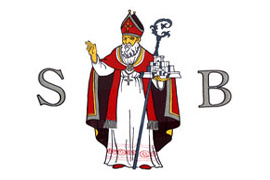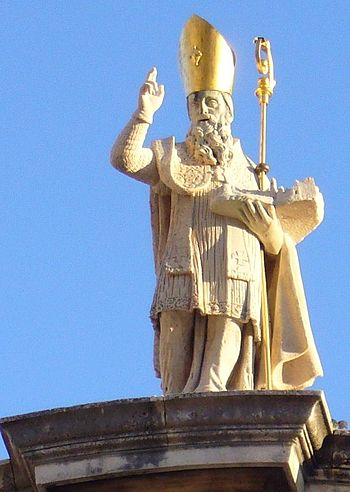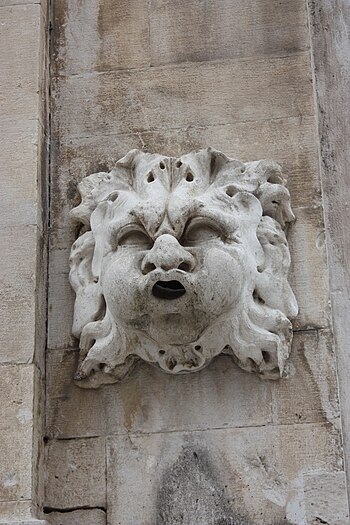| Flag of the Republic of Dubrovnik.Guess who at the centre? (Photo credit: Wikipedia) |
| There are more statues of Sveti in Dubrovnik than you can shake a stick at (Photo credit: Wikipedia) |
| Statue of Saint Blaise, Dubrovnik (Photo credit: Wikipedia) |
| One of the animals Sveti saved? Dubrovnik, (Photo credit: Wikipedia) |
| Dubrovnik: Before this church all the festivities took place (Photo credit: Wikipedia) |
I feel myself constrained today --- I wish it were not so,
but, as we used to say, needs must, in the service of truth and actuality ---
to recount an event part of which I witnessed yesterday, in praise of St
Blaise, the patron saint of Dubrovnik. Indeed, this saint is honoured in many
places in Christendom, and is known by different names, according to the local
languages. When he was first mentioned to me in Dubrovnik, he was called Sveti
Vlaho I thought they said Sweaty Vlaho, and I immediately had the fantasy that
this saint had been a simple man, possibly an illiterate bricklayer or
something of the sort, who attained his sainthood and millennial following from
being kind to the birds that would perch on his shoulders as he laid his
bricks, or on the wall he was building, twittering away merrily as the construction mounted towards what they no
doubt call, in these parts, the heavens.
Perhaps I should pause here by
way of disclosure, to make clear that my attitude towards religions --- all
religions --- is unsympathetic. I know we are always enjoined to respect
everybody’s religion, and I go along with that to the extent that I would not
wish to interfere with anyone’s following of his or her chosen religion. But I
find it more difficult to honestly admit that I can respect the choice a
religious person has made. For, to take the most obvious examples, that would
be to say I respect the opinion of someone who, shall we say, has benefited
from the highest available education, who yet asks me to believe that their
patron came into the world by virgin birth, an event so incredible that it has
never yet been recorded in human history. Or that, their Master having been
executed by Roman soldiers, and placed in his grave in some sort of cave, the
entrance to which was blocked by a huge
stone, nevertheless the corpse found the strength to rise from his grave, roll
aside the huge stone, and then, as they say, “ascend to heaven.”
I find it quite impossible to say
that I respect the actions of believers who propagate such nonsense around the
world as if it were the actual truth. Similarly, to take the case of another
religion, we have seen in recent years the spectacle of hundreds of young
people offering themselves up as suicide bombers, on the promise that their martyrdom
for their cause would earn them when once they have, in their turn, ascended to
heaven, a future in which they will be free to amuse themselves with 72 vestal virgins. Such people live right in our present day, and are wreaking havoc
around the world with insensate acts of
killing people who are totally innocent of whatever actions they might have
been killed for.
And indeed, to return to the case
of Dubrovnik, the protection of their patron Sveta Vlaho may have pulled them
through their recent war against their Serbian, Montenegrin, and Bosnian
neighbours, but it seems not to have guided their thoughts in a particularly noble
direction when their soldiers, engaged in fighting on the ground in defence of
their Bosnian neighbours, suddenly decided to switch sides in mid-battle, and on
the spot undertook a brutal and
treacherous attack on them.
Okay, just to say, I am not a
religious person. Nevertheless It was suggested to me yesterday that I should
have a look at the spectacle laid on by this city and the villagers who ----
everybody told me this as if to suggest these obeisances were the resort of
simple villagers, not of urban sophisticates --- would come flocking in,
wearing their traditional garb, and waving their parish flags as they paraded
before the Bishop, or whoever was the lead character in this drama.
I do not myself enjoy dressing
up, and have a limited taste for it when others do it; I have always hated
flags, the main purpose of which in my experience has been to gather the
faithful into a group ready to attack the bearers of other flags; and the
spectacle of hundreds of priests in their black gowns, colourful robes, fancy
hats and the like, is such as to turn my stomach. So I cannot claim to have greatly enjoyed the
proceedings, although I did wonder why the whole procession was brought to an
end by a solid column of men dressed as Roman soldiers.
The only thing I enjoyed were the
two brass bands. I grew up with brass bands in the far south of New Zealand,
and I have always thrilled to the memory of 26 bands marching towards the Rugby
Park on the occasion of our annual epic struggle against the neighbouring
province to the north. This was before the Second World War, before I reached
my teens. The Dubrovnik band yesterday
did play one of the essential British marches, Colonel Bogey, with which our
proceedings in those far off days were enlivened, but I did feel they had a
musical arrangement which, towards the
end of a phrase, seemed slightly out of tune, at least to my ears.
I have made an effort to discover the origin of Sveti’s sainthood. He was apparently a physician, elevated to
bishop, lived in historical Armenia (modern-day Turkey),
and died by beheading by a Roman legionnaire in 316 AD. At a certain point in
his life he retired to a cavern, to which his good works attracted many people,
hoping to be cured, and also, so it was said, “Even wild animals came in herds to
receive his blessing.” Just like Tarzan,
summoning the wild animals from the jungles.
The most significant miracle he
performed appeared to have been to have somehow helped a boy who was being
choked by a fishbone caught in his throat, by which act he has become,
according to Wikipedia, the favourite saint for curing throat illnesses,
specially for bones stuck in the throat.
Although
he died in the fourth century, the legendary Acts Of Saint Blaise were not written until 400 years later, and
were then used to make him one of the most popular saints of the medieval centuries.
The Dubrovnik celebrations, of which I saw the first half hour or so,
apparently ended (again I am indebted to Wikipedia) “when relics of the
saint, his head, a bit of bone from his throat, his right hand and his left,
are paraded in reliquaries.”
A part I must have missed, again described in
Wikipedia, was when “two candles are consecrated, generally by a prayer,
these are then held in a crossed position by a priest over the heads of the
faithful or the people are touched on the throat with them. At the same time
the following blessing is given: ‘May Almighty God at the intercession of St.
Blaise, Bishop and Martyr, preserve you from infections of the throat and from
all other afflictions’. Then the priest makes the sign of the cross over the
faithful.”
I guess, in this modern world,
surrounded by its overload of information, you decide what you are going to pay
obeisance to, and then do your stuff. Or not.




No comments:
Post a Comment